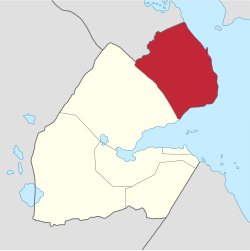Obock Region
| Obock Region | |
|---|---|
| Region | |
 |
|
 |
|
| Coordinates: 11°58′N 43°18′E / 11.967°N 43.300°ECoordinates: 11°58′N 43°18′E / 11.967°N 43.300°E | |
| Country |
|
| Capital | Obock |
| Area | |
| • Total | 4,700 km2 (1,800 sq mi) |
| Population (2009) | |
| • Total | 37,856 |
| • Density | 8.1/km2 (21/sq mi) |
| ISO 3166 code | DJ-OB |
The Obock Region (Somali: Gobolka Obock, Afar: Obock Rakaakay) is a region in northern Djibouti. It has a land area of 4,700 square kilometres (1,800 sq mi), and had a population of 37,856 in 2009.
In the mid-19th century and earlier, Obock was ruled by Somali and Afar Sultans, local authorities with whom France signed various treaties between 1883 and 1887 to first gain a foothold in the region. The French developed Obock as a colonial port, while the Italians maintained a port to the north of Obock at Assab.
Obock region became a separate administrative entity in 1927, with Michel Azenor appointed as chief.
The region covers an area of 4,700 square kilometres (1,800 sq mi). It is bordered by Eritrea to the north, the Tadjourah Region to the southwest, and the Red Sea and Gulf of Aden to the east. There are several salt-lakes on the road to Tadjoura.
The regional capital is Obock, which is positioned on the Gulf of Tadjoura littoral. The city has a functional airstrip and offers regular ferry services to Djibouti City. Other notable towns include Daddato, Khor Angar, Andali, Bissidiro, Moulhoule, Alaili Dadda`, Waddi, Lahassa, Egahlou and Ribta.
...
Wikipedia
